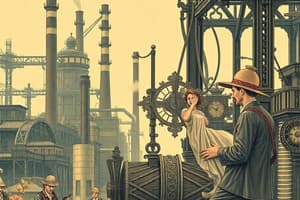Podcast
Questions and Answers
Manufacturers who wanted to increase output hired unskilled wage laborers who did not require training in all facets of a particular task, resulting in factories slowly replacing what?
Manufacturers who wanted to increase output hired unskilled wage laborers who did not require training in all facets of a particular task, resulting in factories slowly replacing what?
- Farms
- Shops (correct)
- Mills
- Mines
Immigrants of what cultural community, halting from southwestern Germany and Poland, moved to the U.S. via chain migration and in family units?
Immigrants of what cultural community, halting from southwestern Germany and Poland, moved to the U.S. via chain migration and in family units?
- Jewish (correct)
- Catholic
- Protestant
- Hindu
In 1825, what 350-mile-long canal was completed by New York State?
In 1825, what 350-mile-long canal was completed by New York State?
Erie Canal
What U.S. city established the first long-distance railroad line in 1827?
What U.S. city established the first long-distance railroad line in 1827?
Where was the first modern textile mill built in 1821?
Where was the first modern textile mill built in 1821?
What type of emancipation laws did Vermont and Pennsylvania pass in the late 18th century?
What type of emancipation laws did Vermont and Pennsylvania pass in the late 18th century?
What U.S. region saw slow railroad development during the 19th century?
What U.S. region saw slow railroad development during the 19th century?
Which religion did nativists particularly oppose during the 19th century?
Which religion did nativists particularly oppose during the 19th century?
What triangular community was formed by German immigrants in rural areas like St. Louis, Cincinnati, and Milwaukee?
What triangular community was formed by German immigrants in rural areas like St. Louis, Cincinnati, and Milwaukee?
Labor activists in the 1840s pushed for how many hours of work across all industries?
Labor activists in the 1840s pushed for how many hours of work across all industries?
What institution did the U.S. labor movement challenge during the 1840s?
What institution did the U.S. labor movement challenge during the 1840s?
The free black population in the U.S. expanded from ca. 60,000 in 1790 to what number by 1810?
The free black population in the U.S. expanded from ca. 60,000 in 1790 to what number by 1810?
What movement aimed at improving road, canal, and railroad networks?
What movement aimed at improving road, canal, and railroad networks?
What economic and political system contributed to the gap between wealthy businessmen and impoverished wage laborers?
What economic and political system contributed to the gap between wealthy businessmen and impoverished wage laborers?
How many immigrants arrived in the U.S. from 1820 to 1860?
How many immigrants arrived in the U.S. from 1820 to 1860?
What labor-intensive duty were many women relieved from due to mechanized production?
What labor-intensive duty were many women relieved from due to mechanized production?
Flashcards are hidden until you start studying
Study Notes
Labor and Manufacturing
- Manufacturers increased output by hiring unskilled wage laborers, moving away from traditional apprenticeship systems in shops.
- Factories began replacing small shops, enhancing productivity and reducing long-term obligations for workers.
Immigration Patterns
- Jewish immigrants from southwestern Germany and Poland engaged in chain migration, settling primarily in urban areas and taking up jobs in retail and artisanal trades.
Transportation Innovations
- The Erie Canal, completed in 1825, spanned 350 miles, connecting the Great Lakes to the Atlantic Ocean, significantly boosting agricultural and industrial trade.
- Baltimore established the first long-distance railroad line in the U.S. in 1827, facilitating transportation of goods to the Appalachian West.
Industrial Development
- Francis Cabot Lowell introduced the powered loom design from England to the U.S., leading to the first modern textile mill in Massachusetts in 1821.
Slavery and Emancipation
- Northern States passed gradual emancipation laws in the late 18th century, allowing future children of enslaved mothers freedom but requiring them to serve indentured terms.
- By the early 19th century, the movement for emancipation began slowly, with a free black population in New England having certain rights but still limited in growth.
Regional Variations
- The South lagged in railroad development throughout the 19th century compared to the North.
Nativism and Social Tensions
- A significant backlash against immigrants, especially Catholics, arose from native Anglo-Protestants during the 1820s-1860s, leading to the formation of the American Party (Know-Nothing Party).
Community Formation
- Many Catholic and Jewish immigrants helped form the "German Triangle," thriving in cities like St. Louis, Cincinnati, and Milwaukee.
Labor Rights Movement
- The New England Association of Farmers, Mechanics, and Workingmen pushed for a ten-hour workday and campaigned for improved working conditions for children.
Economic Context
- The U.S. labor movement of the 1840s promoted the Northern system of commerce, opposing the extension of slavery into new territories.
Transportation and Economic Growth
- The Transportation Revolution focused on developing sectors like roads, canals, and railroads, enhancing access to the West.
Economic Disparities
- Capitalism deepened the divide between wealthy business owners and impoverished wage laborers, leading to increased social awareness of economic inequalities.
Immigration Impact
- From 1820 to 1860, over 5 million immigrants, including large numbers of Irish, Germans, and Jews, settled in the U.S., constituting about 12.5% of the population by 1860.
Gender Roles in Economy
- The market revolution transitioned women from traditional producers of goods to consumers, allowing them to work as seamstresses and in other wage-earning capacities.
Studying That Suits You
Use AI to generate personalized quizzes and flashcards to suit your learning preferences.





